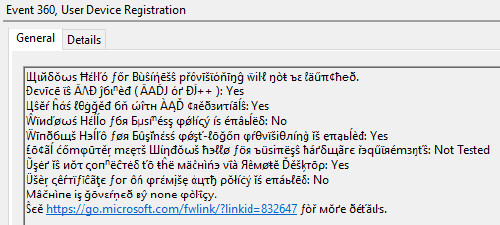MailItem in changing times.
According to the
documentation,
the first parameter of the Reply (and ReplyAll, and Forward)
events on a MailItem event in Outlook is “the new item being sent in
response to the original message”.
Uh, no. At least in VSTO; not sure about VBA, but I cannot see how it
could be different there given that VSTO is a wrapper around the same
COM interfaces. The argument is the original item that is being
responded to:
void OnReply(object Response, ref bool Cancel)
{
Cancel = false;
if (Response is Outlook.MailItem item) {
string html = item.HTMLBody;
int pos = html.LastIndexOf("</body>");
item.HTMLBody = html.Insert(pos, "This is the modified item. ");
}
}
After this handler runs, the original item that was replied to will
have the new sentence at the end, while the reply is entirely
original. I suppose this means that the response message is created
first, and then the event fires with the wrong argument.
Helpfully, though, when using Outlook’s preview/reading pane (whatever
its name is this afternoon) the InlineResponse event on the
Explorer object actually gets the correct message, i.e. the new one.
Trust Issues
After developing a new Outlook VSTO add-in, I noticed that at the
first start after installing it (by the MSI method), Outlook would
display a trust warning. The add-in is unsigned, but this should still
not happen based on my experience from other add-ins.
As it turns out, there are two ways to “grant trust to the
solution”:
- Sign the add-in
- Install it into the Program Files directory
The latter presumably works because Office assumes that write access
to Program Files is sufficient evidence of administrative intent.
My installation path was C:\Program Files\Some Company\SomeAddin.
Huh. Now what?
…
… oh no, they didn’t …
… yes, they did.
Can you guess?
S
P
O
I
L
E
R
S
P
A
C
E
OK, a hint. The “Program Files” directory?
S
P
O
I
L
E
R
S
P
A
C
E
Either you have figured it out by now, or are hungry for the
solution (because why else would you still be reading this?), so here
it is:
The “Program Files” directory they talk about is the same “Program
Files” directory that Office is installed in. My scenario involved a
.NET assembly compiled to MSIL, so naturally I put it into the 64-bit
Program Files directory because that one is more native to the system.
The Office installation, however, was still 32-bit, and Outlook came
to the (well, partially) unreasonable conclusion that:
"C:\Program Files\" != "C:\Program Files (x86)\"
Therefore the add-in was not installed in the Program Files directory,
and therefore not to be trusted by default.
A Bitmap, wrapped in a knotted Ribbon.
Writing Office add-ins has always been a bit of a dark art because
there is not really all that much documentation, and what there is,
tends to, let’s say, have been overtaken by events.
This is particularly true where VSTO, the Visual Studio Tools for
Office, otherwise known as the .NET wrappers around the COM add-in
API, is concerned. Even a seemingly simple task like finding out
correct signatures for callback methods can be surprisingly difficult
because the authoritative
page
still only mentions Office 2007, and you can never know what may have
changed in the last 13 years. (Wow. Has it been that long?)
OK, enough of the empty complaining. Let’s get to the useful
information. Everything below is based on current Office 365 with the
latest VSTO version as of today, 10.0.60724.
The loadImage callback
The correct C# signature for the callback method named in <customUI loadImage="LoadImageCallback"> is:
public Bitmap LoadImageCallback(string imageId)
There are various discussions around the Internet on whether this
method should return Bitmap or stdole.IPictureDisp, or whether
Bitmap works everywhere except Outlook.
Bitmap works everywhere including Outlook.
Namespaces and idQ
When using the idQ attribute to identify controls, you may notice
that your callbacks aren’t. Called, that is. This is explained in a
paragraph about one-third down the page linked above:
If you use a COM add-in to customize the Fluent UI, the namespace
name must be the ProgID of the COM add-in, but the behavior is
otherwise the same. When you use a shared add-in, the ProgID is
AddInName.Connect. When you use Microsoft Visual Studio 2005 Tools
for the 2007 Microsoft Office System (Visual Studio 2005 Tools for
Office Second Edition) to create the add-in, the ProgID is the
name of the add-in.
(Emphasis mine.)
VSTO is actually older than the W3C recommendation on “Namespaces in
XML 1.0”, Second
Edition,
so I have to admit that the idea did not contradict the spec at the
time. (The original recommendation from 1999 mentioned that the intent
was to use URIs, but did not yet require it.)
However, I fail to see the reason why the namespace ID must be the
add-in’s name, unless it is the result of a very ugly shortcut in the
implementation of the “Fluent” UI, i.e. the Ribbon. It would be
entirely simple for the host application to associate any string with
the add-in whose GetCustomUI() returned the particular bit of XML.
By the way, the “name of the add-in” in the VSTO case above, that the
namespace ID has to match, is the name of the subkey of
SOFTWARE\Microsoft\Office\...\Addins. In addition to being true
empirically, it also matches the non-VSTO case because the only place
where the ProgID is involved in the process of loading an add-in is
that Registry key.
Ein Körnchen Wahrheit.
Daß Versandbenachrichtigungen immer gelogen sind, weil sie im
Zweifelsfall dadurch ausgelöst werden, daß der Aufkleber erzeugt wird,
ist ja nicht neu. Neu ist, daß jemand die Lüge aus der Überschrift
schon im ersten Satz so klar entlarvt.

Clap. Clap. Clap.
There is a new Windows 10 “functional update”, so of course we also
need new Intel network drivers for our VLANs. Intel have been really
laying on the speed this time; three weeks from general availability
(of 2004) to a driver release is a new record, I think.
Hey! Great job! Let’s all run and install the new 25.1.1
drivers
today!
Unless … you aren’t feeling particularly sentimental about the *-NetAdapter
cmdlets, are you? The ones you just got back in 25.0 after creating any VLANs
used to break them
for the longest time?
You are? Oh. Then I may have a bit of bad news for you.
Yes. They’re gone again; same error as before. Someone forgot to merge
the fix branch, I suppose.
What do I hear you say? Is it “Quick! Let everyone know! On the Intel
forum where they
announced the release and asked for feedback!”, perhaps?
Oh. Then I may have a bit of bad news for you.
You see, the Intel forums have just gone
read-only for several days
while they are “transitioning to a new platform”, which will also have a new
URL.
Great timing. Really great timing.
See hugo go.
… and to think it only took me three months to notice that the front
page was empty, and only another three to fix that.
In excess of requirements
Well, Jabra, of course your “Jabra Direct” headset setup application
is Chromium based, or whatever enormous rendering engine is en vogue
today. After all, the application has at least five pages to show, and
ten buttons or so, so clearly you need a full-blown web browser to
show this surfeit of UI.
And of course this means that the two-bit application comes in at
five processes. Efficiency is for the wimps!
And yes, of course closing the windows only does exactly that, but
leaves the five processes running forever, doing God knows what, and
with no sign whatsoever of their presence (such as a tray icon or so).
Another entry on the list of sometimes useful applications that
nonetheless get installed only when needed and then removed
immediately afterwards.
Oh no, not again ...
The Python-on-Windows people are at it again. This time they have
deliberately broken os.path.expanduser() in 3.8.
Until 3.7, expanduser() treated a tilde at the front of the path
given to it the same as a *ix shell, i.e. ‘~/’ was replaced by the
current user’s home directory, and ‘~user/’ with that of user user.
More specifically, it used the value of the HOME environment
variable, or USERPROFILE if the former did not exist, or
HOMEDRIVE\HOMEPATH as a final fallback (on NT 3.51, perhaps?).
Then someone complained about that, Python bug
#36264, and for some reason
unknown to the world, it was decided not to consider HOME anymore.
This (and I’m speaking out of a deep personal animus) was the most
misguided decision since splitting the Windows distribution into 22
MSI packages per architecture.
Why?
Because the supposed rationale for the change is that HOME is not a
“special” variable on Windows, i.e. it is not something the
system/shell cares more about than any other environment variable.
So what? It was documented that it was used by expanduser(), and
that is what matters. Explicitly mentioning some behavior in the
documentation, without a note that it is an implementation detail
subject to change, is what interface contracts are made of.
The documentation does not make any claims that HOME is used because
it is of any particularly exalted rank, it simply says it is used.
The relevant paragraph could even be read simply as “the user’s home
directory, unless overridden with HOME”.
In a particularly cruel twist, the original complainant even pointed
out that their problem was actually caused by a bug in MSYS, but the
Python-on-Windows maintainer apparently felt that this localized
problem with a single tool merited breaking part of the Python
standard library for everyone. (The tool was Git, but still …)
Goodbye Mercurial; it was nice knowing you.
Atlassian have made the extremely regrettable
decision
to stop supporting Mercurial on Bitbucket, suggesting that everyone
migrate their repositories to Git. (They say they “considered”
developing an automated migrator, but ultimately they decided to wash
their hands of the whole affair and just abandon their customers.)
There does not appear to be a viable alternative hosting solution (by
which I mean, none of the dozen or so I looked at are any good), and
I’m not going to run my own server; I have better things to do with my
time.
Unfortunately, this means that a lot of that time I have the
aforementioned better things to do with will be spent converting quite
a few Mercurial repos to Git, and learning how to use that crime
against sanity and humanity, Git.
I have been a user of the excellent
TortoiseHg for many years now, but
apparently this is now going to change. I hope the project will keep
going.
Thanks for nothing, Atlassian.
You missed some.
Microsoft left some things in the Windows 10 1903 release that crept
in during development and should have been removed.
There is certainly a lot more I have not yet encountered.

